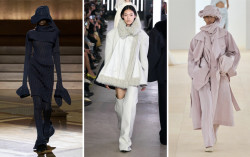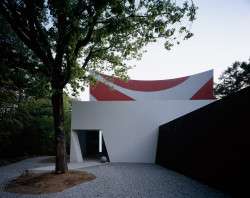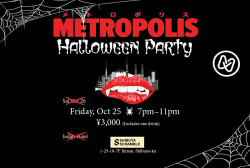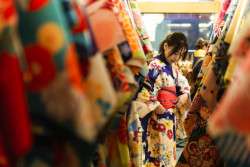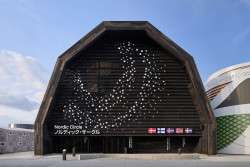
October 28, 2005
Just like heaven
Nokogiri-yama in chiba is as appealing as Nikko or Kamakura, and just as accessible
By Metropolis
Originally published on metropolis.co.jp on October 2005

Photos by Peter McGurk
Hawks swooped and wheeled overhead as I made my way through the village. Seaweed had been left out to dry in the blazing midday sun, and behind me the water in the bay sparkled. On the horizon, Tokyo was an indistinct blur. This was Kanaya, and towering above the town were the sheer rock walls of Nokogiri-yama.
Rising 330m on the western side of Chiba’s Boso Peninsula, the mountain is crowned with the 1,300-year-old Buddhist temple of Nihon-ji.
I scaled the peak and roamed the grounds at the top. If conditions are right, Mt. Fuji is visible as a backdrop to Tokyo, and the vista down the coast of headlands, bays and islands is delightful.
Turning my back on the view, I picked my way along the winding path from the summit and descended a crumbling staircase of rocks and tree trunks. I emerged into a dusty parking lot complete with small ticket office. The ¥600 entrance fee to the temple proper covered all of its attractions.
The path beyond twisted between towering trees and snaked into a clearing where carved into the sheer walls of the cliff face was a 30ft-high image of Kannon, the Buddhist Goddess of Mercy. The sheer scale and serenity of the site, coupled with its location, was extraordinary. My feelings did dim a little later, though, when I discovered that this seemingly age-worn carving only dated back to the ’60s.
Also not to be missed, just around the corner from the Kannon and up a dozen steep flights of steps, is the Ruriko Observatory. Overhanging a dizzying drop, the viewing platform offered a panorama of the bay and the brown and green rolling hills of southern Chiba. The vista made the steep climb worthwhile.

These are not Nokogiri-yama’s main draws, though. That honor is reserved for the Daibutsu of Nihon-ji. Easily the largest Buddha statue in Japan, the Daibutsu is, at 31m, twice as tall as the one in Kamakura and, more importantly, only half as crowded. It was completed in 1783 by Jingoro Eirei Ono and his assistants, and enjoyed countrywide fame during the Edo period. The years though, have been unkind, and as its fame lessened, so did its condition. The Buddha was restored in 1969, and today this stately statue cuts an impressive figure perched on the side of the mountain.
The paths that connect the colossal Daibutsu and Kannon, known as Sengohyaku Rakan Michi, are considered holy. The steps are often steep, plunging down only to rise straight back up. Caves and crevices in the rock walls hold small stone arhat figures—Buddhists who achieved nirvana and thus were not reborn.
Created at the same time as the Daibutsu, 1,500 statues line the near-deserted paths on the mountainside. In the deep shade under the forest canopy, I saw figures with pointed skulls, elongated ears, high, flat foreheads and squat, rounded heads. Many of them were grotesquely distorted due to age and were missing features, but a campaign is underway to have them restored.
It is possible to tour these sites in one rushed day, but the simple Kinsenkan Ryokan in nearby Kanaya is worth the stay purely on the merits of its evening meal. The fruits of the sea—sashimi and tempura, crab, ise ebi and sazae—were laid before me on the tatami room’s low wooden table. There was a small indoor onsen, too, billed as having “golden water,” but I just couldn’t get used to lounging in the murky brown-yellow liquid.
Ferries return across the bay on a regular basis, but I wasn’t quite done with mountains and clean air. A 40min bus ride brought me to Mother Bokujo, a functioning farm that attracts mainly families for a day out. Visitors can interact with the cattle, sheep, lambs, horses and pigs in various ways, the highlight being the pig races. Small children cajoled and pushed pigs along an obstacle course urging them to victory, often completely unsuccessfully.
After getting a close-up view of the animals, the next thing to do was eat them. The two most popular restaurants in the place were an outdoor yakiniku spot and a Mongolian-style lamb barbecue, known in Japanese as jingis-kan. I passed.
Mountains and sea, fine views, temples and vast effigies, soaring trees, fine seafood and Genghis Khan; Chiba is far too often overlooked.
To access Nokogiri-yama, take the Keikyu Kurihama line from Yokohama to Keikyu Kurihama (35min/¥410), then a bus from outside the station to the Hama Kurihama port (10min/¥190). One or two ferries an hour go across the bay to Kanaya (25min/¥600); check www.tokyowanferry.com for specific times. Use a cable car to reach Nokogiri-yama, and if you plan on a picnic lunch, be sure to bring a bento. A bus runs from the Kanaya ferry terminal to Mother Bokujo (0439-37-3211, www.motherfarm.co.jp) at 10:35am daily; check with the driver for the return time, as it’s subject to change. Rooms at Kinsenkan (0439-69-2629), which is on the main Kanaya road, run from ¥8,500-¥15,000 a night, including two meals.
[geo_mashup_map]

